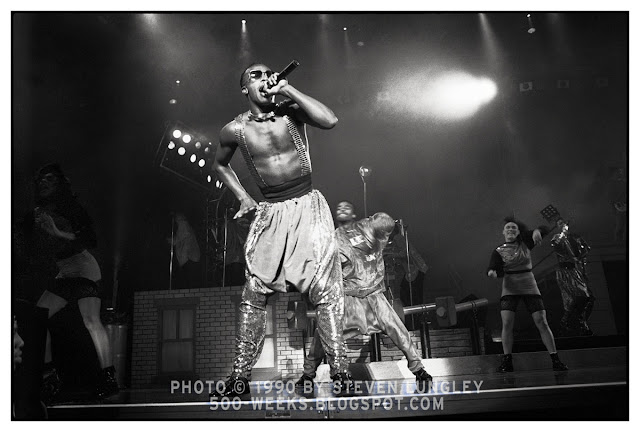Dario Argento sees red
500-Weeks #13
 |
| Dario Argento in Toronto, 1996 |
What do you do when you have to be in two places at the same time? This is the predicament I found myself in in the day I photographed Dario Argento.
Like the majority of photos I was working on at the time, it was created for Eye Weekly, a newspaper, which was printed on a type of paper called newsprint. Newsprint is a truly mediocre medium for photographic reproduction. It has a base colour that is a greyish shade of brown, so anything that is white in the original photo becomes a shade of oatmeal and anything that is dark black becomes a shade of dark brownish grey.
I tried to counter this by combining two approaches to colour. Seamless paper backdrops are a staple of studio photography. They are long and wide and available in many colours, but are impractical to carry to a hotel room. In live theatre plays, the lighting designers will often cover the stage in coloured lighting to set a specific mood, such as blue for night or orange for sunset.
I did tests on how to use theatrical lighting gels in photographic flash units to change different surface tones into expressive colours. After a few attempts, it became second nature to cover the typically beige walls found in hotel rooms in a wash of a single colour. I felt it helped separate the subject from the background, even though most of the intensity of the colour was lost when it was presented on newspaper.
Mr. Argento is an Italian film director best known for his work in horror movies. I had the assignment to photograph him at the exact same time as I had an assignment to photograph someone else.
There were five writers and one photographer working for the same newspaper. As the photographer, my job was to provide portraits for the paper for every subject interviewed by one of the writers. Two of the writers had each booked 20-minute interview slots at the same time.
Both were in the same hotel, the Sheridan Centre in Toronto, but they were in different wings. So I arranged to go with writer number one to their interview and photograph their subject at the beginning of the interview, then pack up my gear, and leave for photo subject number two, which I had arranged to do at the end of their interview slot.
I had to sprint to the elevators and descend 20 or so floors, hustle over to the other end of the hotel and get another elevator back up another 20 floors. Then find the second room, enter quietly and set up and take photo number two. I was a bit sweaty by the time I arrived.
Mr. Argento was the second photo. I knew of him, I knew he primarily made horror films and I knew he had a devoted fan base. I don’t even think I had seen any of his films. I got into the room, spotted the frosted table and large chair and in my mind I instantly knew what I wanted to do. This was going to be gothic.
I had about six minutes, two battery powered flash units and a wide selection of coloured gels, all cut to fit inside the filter slot on the flash units.
The chair and table got moved into position. I placed a red gel into one flash and placed it behind him, resting on a small hotel garbage bin turned upside down. I aimed the flash at the wall and started checking the amount of light with my light meter. Then I put a green gel into the other flash and stuck it under the frosted glass table in front of him. Similar procedure, taking light meter readings off the top of the glass and adjusting the amount of green light based on my previous tests. I'm sure Mr. Argento must have wondered what I was up to. Finally, I pulled the curtains closed until they provided just enough light onto his face.
If I had a third light, I am sure I would have lit him from below, but three lights was too much to carry on my own.
I then exposed one roll of film – 12 frames – through my Rolleiflex camera. I don’t remember talking to Mr. Argento too much, if at all. In many of the frames he looks bored. I am sure he had no idea what I was up to. The colours are only visible in the processed film, not on set while the photos are being taken. A bonus was noticing the green tinge to the whites of his eyes.
Technical stuff: Camera: Rolleiflex TLR with 75mm f/3.5 Schneider Xenar lens and outfitted with a Beattie Intenscreen ground glass using Fuji Super-G 400 colour negative film.
Lighting: Window light combined with two Vivitar 285hv flash units powered with Lumedyne Mini-cycler external battery packs.


Comments
Post a Comment